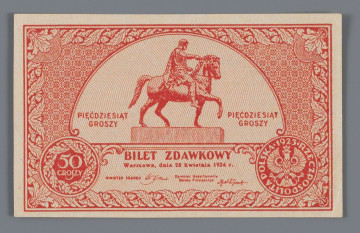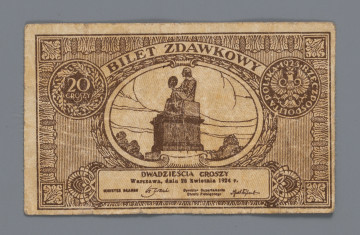
50 groshes [Polish: grosze]
1924
National Museum in Lublin
Part of the collection: Paper money during the Second Polish Republic
The period when the Polish mark was in force in the Polish monetary system brought extremely high inflation to the country. In the second half of 1923, the dollar exchange rate reached 6,000,000, and at the beginning of 1924 – 10,250,000 marks. In this situation, Władysław Grabski's Cabinet was appointed on 19 December 1923, with the Prime Minister also taking up the post of Treasury Minister. The main aim of the appointment of the Cabinet, which included representatives of Związek Ludowo-Narodowy, Chrześcijańska Demokracja, Polskie Stronnictwo Ludowe ‘Piast’ and non-party professionals, was to improve the country's economic situation. The primary task was to stabilise public finances. To this end, steps were taken which historiographers refer to as the Grabski reform. One of Grabski's main moves was to change the currency system. To this end, Bank Polski was established in January 1924 in place of the hitherto existing Polish National Loan Fund, and was to become the issuer of the new currency, the zloty. The situation was urgent, as the monthly inflation rate was at the time several dozen percent, and in October 1923 it even reached 300 percent. The start of the exchange of Polish marks into zlotys at a ratio of 1,800,000:1 was set for 28 April 1924. The need for rapid change resulted in a lack of time to prepare the coins. Therefore, a decision was made to introduce the so-called pass tickets into circulation, with the State Treasury, not Bank Polski, becoming the issuer. In the case of the one- and five-groszy tickets, it was decided to reuse the existing 500,000 and 10,000,000 Polish mark banknotes. To this end, the banknotes were cut in half and then new markings were applied to both sides of the halves with red paint. The obverse bore, among others, a drawing of a one-grosz coin, the denomination and the signatures of Władysław Grabski, Minister of the Treasury, and Feliks Młynarski, Director of the Monetary Circulation Department. The reverse bears the text of a clause confirming the legitimacy of using treasury tickets as means of payment. The tickets did not have their own series and number designation. For this purpose, reprinted banknote designations were used, as in the presented CU series, bearing the number 468025*.
Leszek Poniewozik
Dimensions
cały obiekt: height: 74 mm, width: 80 mm
Technique
Material
paper
Creation time / dating
Creation / finding place
Owner
The National Museum in Lublin
Identification number
Location / status

1924
National Museum in Lublin

1924
National Museum in Lublin

1924
National Museum in Lublin
DISCOVER this TOPIC
Castle Museum in Łańcut
DISCOVER this PATH
Educational path